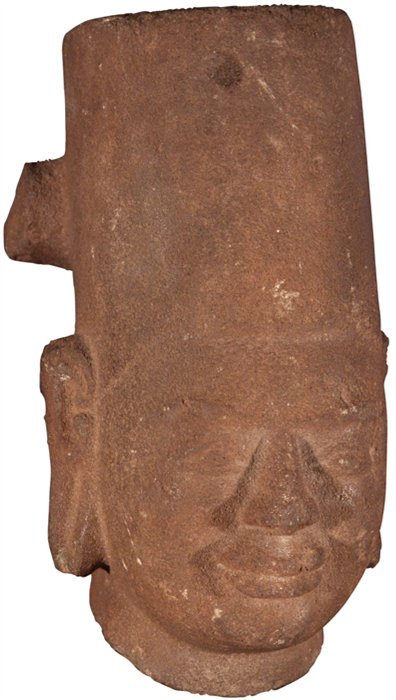23. Head of Vishnu with mitre,
Free-standing, Sandstone, height 20 cm,
Pre-Angkorian Khmer art, 7th Century.
The god’s entourage consists of Uma or Parvati, his consort (Sanskrit: “sakti”), the bull Nandin, his mount, but also Ganesha, his son, who can be identified by his elephant head and – very rarely – Skanda, his other son. Each and every one has his own history, legitimacy and constitutes the essential element of a perfectly ordered religious system.
Vishnu, “he who penetrates all” in Sanskrit, is in the Brahman triad, with Shiva and Brahma; he whose task it is to ensure the perpetuity of the world between the time of its creation by Brahma and its destruction by Shiva. Four-handed Shiva is generally represented with a disk and a conch shell (upper hands), a sledgehammer and a small ball (lower hands), and he may be riding his mount Garuda. His spouse, his “sakti”, is Lakshmi or Sri, born from the churning of the ocean of milk.
Vishnu also incarnates various avatars (Sanskrit: “descent”) to fight the demons (the Asura) who combat the gods. These avatars are not random, but are organised according to a succession that is unchangeable in cosmic time: among these avatars, let us cite only Rama for the moment, the hero of the Ramayana and Buddha of whom, though it is often forgotten, representations are also found in Brahmanism.
Brahma is present, but more rarely, in Cham iconography. Graced with four heads (three, in fact, as the back one cannot physically exist in a high or low relief seen straight on). His consort, Sarasvati, is more difficult to identify for her part, often iconographically similar to Uma or Lakshmi.
Buddhism in Cham sculpture finds far less expression than Brahmanism. It is essentially, but not exclusively, illustrated in the Dong Duong style (ninth and tenth centuries), where Buddhas and bodhisattvas are present, although Chinese Annals already evoked in the Linyi era Hinayana (“small vehicle”) Buddhist monks. The Buddhist iconography used is classic: monastic clothing, “usnisha” (bump on the skull) and sometimes “urna” (tuft of hair between the eyebrows). On the contrary, bodhisattvas, characteristic of the Mahayana, are found much more often, also dateable from the Dong Duong period: Avalokitesvara wears the image of the Buddha Amitabha in his hair. Prajnaparamita sometimes seems to be Avalokitesvara’s companion; as he does, she wears Amitabha in her hair. Vajrapani, with the Vajra (“diamond lightning”) as his main attribute, is also found. Buddhism does not seem ever to have been the state religion in Champa, but more the personal inclination of the sovereign. When he founded Dong Duong during the second half of the ninth century, King Indravarman II rendered homage to Laksmindra Lokesvara, the other name for Avalokitesvara, but also – in the foundation stela – to Shiva Bhadresvara and thereby explicitly to Shivaism. This syncretism can equally be identified in the second stela at Dong Duong, which informs us that Haradevi, queen and widow of the king Pramabuddhaloka, had Hindu images mounted. Let us simply remember that Hara is another name for Shiva.
In addition to these divinities, Brahman or Buddhist, one encounters other representations, secondary, but shared by the two religions, such as certain animals (lion, naga, deer or gazelle) or the gods of directions (dikpalaka). The latter are placed essentially in the courtyards of temples and more rarely on slabs placed on entablatures or on door lintels, among them, Indra, perched on his mount, the elephant Airavata, or Vayu on his mount, the horse. The dvarapala are also present, these guardians of the doors of temples that are always in pairs, one looking benevolent, the other terrifying.
Animals can also be part of the statuary of a temple: lions (as they were imagined, since the Chams could not have seen such an animal as no lions lived in Champa), elephants that are very realistic as they were native to Champa, Garuda, Naga (“snakes”), and monkeys, among others.
Finally, one must add the characters of the main Indian epics (the Ramayana and the Mahabharata) such as Rama, Sugriva, and Hanuman, who, having left the anonymity of the species, incarnated as the heroes of the most famous epics of Indian history.
We must note that it can be difficult to identify not only certain divinities themselves, but also the register (religious or decorative) to which they belong.
